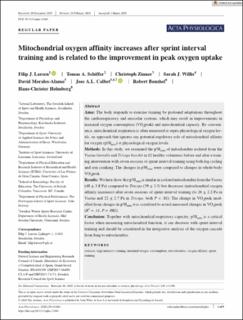| dc.contributor.author | Larsen, Filip J. | |
| dc.contributor.author | Schiffer, Tomas A. | |
| dc.contributor.author | Zinner, Christoph | |
| dc.contributor.author | Willis, Sarah J. | |
| dc.contributor.author | Morales-Alamo, David | |
| dc.contributor.author | Calbet, Jose Antonio Lopez | |
| dc.contributor.author | Boushel, Robert | |
| dc.contributor.author | Holmberg, Hans-Christer | |
| dc.date.accessioned | 2021-06-04T15:13:38Z | |
| dc.date.available | 2021-06-04T15:13:38Z | |
| dc.date.created | 2021-01-27T16:59:47Z | |
| dc.date.issued | 2020 | |
| dc.identifier.citation | Acta Physiologica. 2020, 229(3), Artikkel e13463. | en_US |
| dc.identifier.issn | 1748-1708 | |
| dc.identifier.uri | https://hdl.handle.net/11250/2757993 | |
| dc.description | This is an open access article under the terms of the Creative Commons Attribution-NonCommercial License, which permits use, distribution and reproduction in any medium, provided the original work is properly cited and is not used for commercial purposes. | en_US |
| dc.description.abstract | Aims: The body responds to exercise training by profound adaptations throughout the cardiorespiratory and muscular systems, which may result in improvements in maximal oxygen consumption (VO2peak) and mitochondrial capacity. By convenience, mitochondrial respiration is often measured at supra-physiological oxygen levels, an approach that ignores any potential regulatory role of mitochondrial affinity for oxygen (p50mito) at physiological oxygen levels.
Methods: In this study, we examined the p50mito of mitochondria isolated from the Vastus lateralis and Triceps brachii in 12 healthy volunteers before and after a training intervention with seven sessions of sprint interval training using both leg cycling and arm cranking. The changes in p50mito were compared to changes in whole-body VO2peak.
Results: We here show that p50mito is similar in isolated mitochondria from the Vastus (40 ± 3.8 Pa) compared to Triceps (39 ± 3.3) but decreases (mitochondrial oxygen affinity increases) after seven sessions of sprint interval training (to 26 ± 2.2 Pa in Vastus and 22 ± 2.7 Pa in Triceps, both P < .01). The change in VO2peak modelled from changes in p50mito was correlated to actual measured changes in VO2peak (R2 = .41, P = .002).
Conclusion: Together with mitochondrial respiratory capacity, p50mito is a critical factor when measuring mitochondrial function, it can decrease with sprint interval training and should be considered in the integrative analysis of the oxygen cascade from lung to mitochondria. | en_US |
| dc.language.iso | eng | en_US |
| dc.subject | exercise | en_US |
| dc.subject | high intensity training | en_US |
| dc.subject | maximal oxygen consumption | en_US |
| dc.subject | mitochondria | en_US |
| dc.subject | oxygen affinity | en_US |
| dc.subject | sprint training | en_US |
| dc.title | Mitochondrial oxygen affinity increases after sprint interval training and is related to the improvement in peak oxygen uptake | en_US |
| dc.type | Peer reviewed | en_US |
| dc.type | Journal article | en_US |
| dc.description.version | publishedVersion | en_US |
| dc.rights.holder | © 2020 The Authors | en_US |
| dc.source.pagenumber | 9 | en_US |
| dc.source.volume | 229 | en_US |
| dc.source.journal | Acta Physiologica | en_US |
| dc.source.issue | 3 | en_US |
| dc.identifier.doi | 10.1111/apha.13463 | |
| dc.identifier.cristin | 1880643 | |
| dc.description.localcode | Institutt for fysisk prestasjonsevne / Department of Physical Performance | en_US |
| dc.source.articlenumber | e13463 | en_US |
| cristin.ispublished | true | |
| cristin.fulltext | original | |
| cristin.qualitycode | 1 | |
